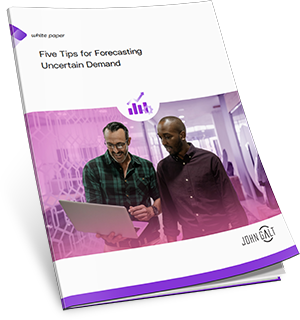Forecasting is the art of knowing today what will happen tomorrow. You want to determine what will happen in the future so you can make decisions today. It’s mostly a planning tool that helps you eliminate as much uncertainty as possible. The forecasting tool relies mostly on data from the past. Not just sales data but also data that has a high correlation with the data you’re trying to predict.
Quantitative vs qualitative forecasting
When making forecasts, there are 2 main methods to get to an outcome. Either the quantitative approach of the qualitative approach.
Examples of the quantitative approach are:
- The naïve approach
- Moving averages
- Exponential smoothing
- Trend projection
Examples of the qualitative approach are:
- Executive opinion
- Delphi model
- Salesforce estimates
- Consumer surveys
When you’re just starting a business or a new product line you don’t have any valid data yet to forecast on. Often the qualitative approach is used in that case. The subjective judgment and opinion of management, sales or consumers are asked.
The quantitative model lets us forecast the future based on past data. It’s usually a more reliable way of forecasting. Especially when you have a few years of data and multiple correlating datasets.
Download the white paper, Five Tips for Forecasting Uncertain Demand
 Effective demand forecasting is a demanding activity based on a branch of mathematics - statistics - that’s nonintuitive to most laymen. Gartner’s supply chain benchmarking research shows that best-in-class companies can achieve forecast accuracy of eighty percent or higher. Given that no forecast made without a crystal ball is ever perfect, eighty percent sounds very good...
Effective demand forecasting is a demanding activity based on a branch of mathematics - statistics - that’s nonintuitive to most laymen. Gartner’s supply chain benchmarking research shows that best-in-class companies can achieve forecast accuracy of eighty percent or higher. Given that no forecast made without a crystal ball is ever perfect, eighty percent sounds very good...
The simplest quantitative method is naïve forecasting. You just use last months’ input to create next months’ forecast. There’s no attempt to adjust that outcome. It’s usually used to compare with the more sophisticated forecasts made by planning tools.
The moving average method is a little but more sophisticated. It uses more data points spaced out equally over time. If you do 12 months moving average time series you’re continually recomputing the data as new data comes in. So, if you have a new month of data added to your moving average, the oldest month will fall of the chart and won’t be computed to recalculate the new moving average.
With exponential smoothing we still consider older data, but we give it progressively less weight in the calculation. This technique detects significant change by ignoring fluctuations irrelevant to the purpose at hand.
Newer data is given more weight. Older data is almost “forgotten”. You could compare it to your own life. If you’re driving to your work every day and your note the amount of time it took to get there, you’ll get to a certain average within a few days.
You’ll also be able to ignore the biggest fluctuations rather quickly. If it normally takes you an hour to drive there, having a day where it takes you two hours to get to work will probably be ignored.
The trend projection method is a method that is one of the more classical methods of forecasting. You need a lot of time series data to be able to make a reliable trend projection. For a long-standing firm it’s easy to collect all the relevant data from its departments to make the projection accurate. Startups usually use competitive data available in the market to be able to make the projection.



